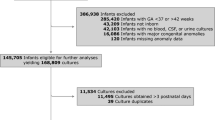Abstract
Background
This study aimed to describe the clinical characteristics of group B Streptococcus (GBS) sepsis in infants aged 4–90 days [late onset (LO)] compared to infants >90 days of age [very late onset (VLO)].
Methods
Microbiology records at Children’s Medical Center Dallas were screened. Demographic, clinical, and outcome data were collected for infants with GBS recovered from blood or cerebrospinal fluid culture from January 1, 2006 to July 1, 2012.
Results
Totally 48 infants were identified (42 LO, 6 VLO). Infants with VLO sepsis had lower median gestational age (28.5 vs. 39 weeks gestation, P<0.001) and longer median nursery admissions (8.8 vs. 0.5 weeks, P=0.004). When gestational age was controlled for, there were no differences in clinical presentation, intensive care unit admission, length of stay, neurodevelopmental outcome, and mortality. Infants with VLO sepsis were more likely to receive vancomycin (83% vs. 33%, P=0.02) or third-generation cephalosporins (83% vs. 24%, P=0.009), and more likely to continue on those agents even after GBS was identified.
Conclusions
Infants with VLO sepsis had lower gestational ages and longer nursery stays than infants with LO sepsis. Beyond age at presentation, there were no significant differences in clinical presentations, hospital course, frequency of neurodevelopmental sequelae, and mortality in infants presenting with LO vs. VLO GBS sepsis. Infants with VLO sepsis were more likely to receive empiric broad spectrum antimicrobials and more likely to continue receiving broad therapy even following GBS identification.
Similar content being viewed by others
References
Stoll BJ, Hansen NI, Sanchez PJ, Faix RG, Poindexter BB, Van Meurs KP, et al. Early onset neonatal sepsis: the burden of group B Streptococcal and E. coli disease continues. Pediatrics 2011;127:817–826.
American Academy of Pediatrics. Group B Streptococcal infections. In: Pickering LK, Baker CJ, Kimberlin DW, Long SS, eds. Red Book: 2012 Report of the Committee on Infectious Diseases. Elk Grove Village, IL: American Academy of Pediatrics, 2012.
Centers for Disease Control and Prevention. Trends in perinatal group B streptococcal disease-United States, 2000–2006. MMWR Morb Mortal Wkly Rep 2009;58:109–112.
Berardi A, Rossi C, Lugli L, Creti R, Bacchi Reggiani ML, Lanari M, et al. Group B streptococcus late-onset disease: 2003–2010. Pediatrics 2013;131:e361–368.
Libster R, Edwards KM, Levent F, Edwards MS, Rench MA, Castagnini LA, et al. Long-term outcomes of group B streptococcal meningitis. Pediatrics 2012;130:e8–15.
Guilbert J, Levy C, Cohen R, Delacourt C, Renolleau S, Flamant C. Late and ultra late onset Streptococcus B meningitis: clinical and bacteriological data over 6 years in France. Acta Paediatr 2010;99:47–51.
Hussain SM, Luedtke GS, Baker CJ, Schlievert PM, Leggiadro RJ. Invasive group B streptococcal disease in children beyond early infancy. Pediatr Infect Dis J 1995;14:278–281.
American Academy of Pediatrics. Pneumococcal infections. In: Pickering LK, Baker CJ, Kimberlin DW, Long SS, eds. Red Book: 2012 Report of the Committee on Infectious Diseases. Elk Grove Village, IL: American Academy of Pediatrics, 2012.
Siegel JD, McCracken GH Jr, Threlkeld N, Milvenan B, Rosenfeld CR. Single-dose penicillin prophylaxis against neonatal group B streptococcal infections. A controlled trial in 18,738 newborn infants. N Engl J Med 1980;303:769–775.
Wendel GD Jr, Leveno KJ, Sánchez PJ, Jackson GL, McIntire DD, Siegel JD. Prevention of neonatal group B streptococcal disease: A combined intrapartum and neonatal protocol. Am J Obstet Gynecol 2002;186:618–626.
Edwards MS, Lane HJ, Hillier SL, Rench MA, Baker CJ. Persistence of functional antibodies to group B streptococcal capsular polysaccharides following immunization with glycoconjugate vaccines. Vaccine 2012;30:4123–4126.
Author information
Authors and Affiliations
Corresponding author
Rights and permissions
About this article
Cite this article
Cantey, J.B., Baldridge, C., Jamison, R. et al. Late and very late onset group B Streptococcus sepsis: one and the same?. World J Pediatr 10, 24–28 (2014). https://doi.org/10.1007/s12519-014-0450-8
Received:
Accepted:
Published:
Issue Date:
DOI: https://doi.org/10.1007/s12519-014-0450-8




